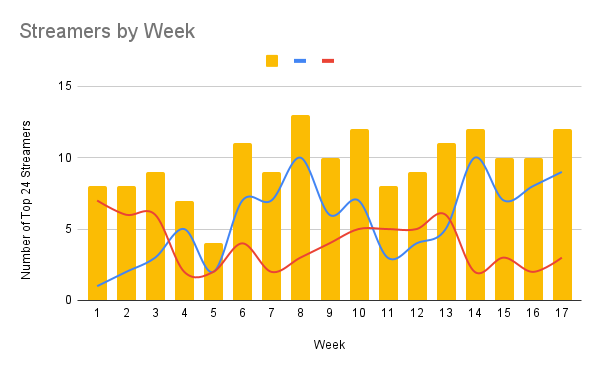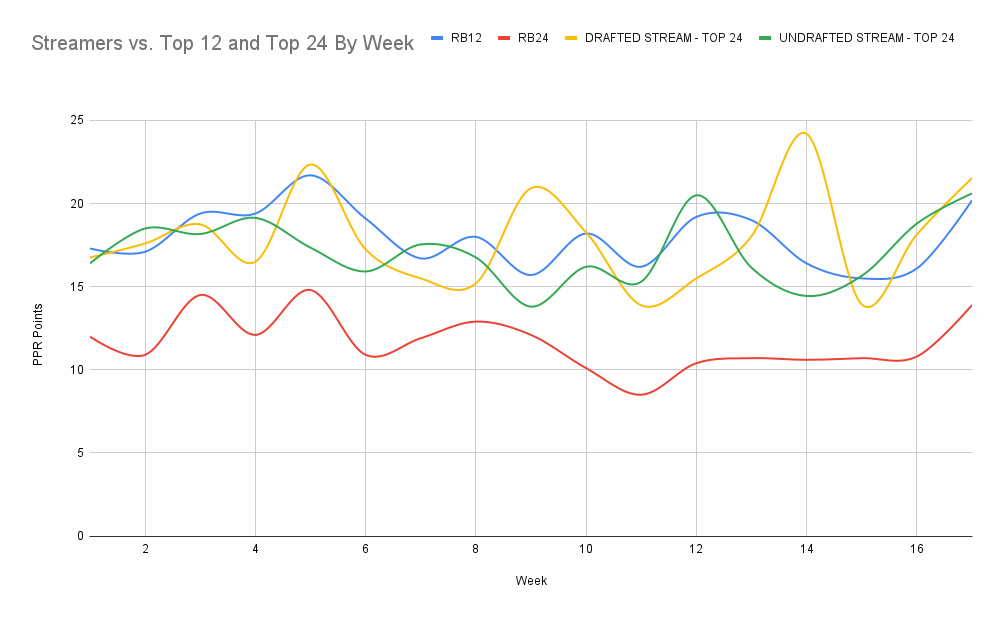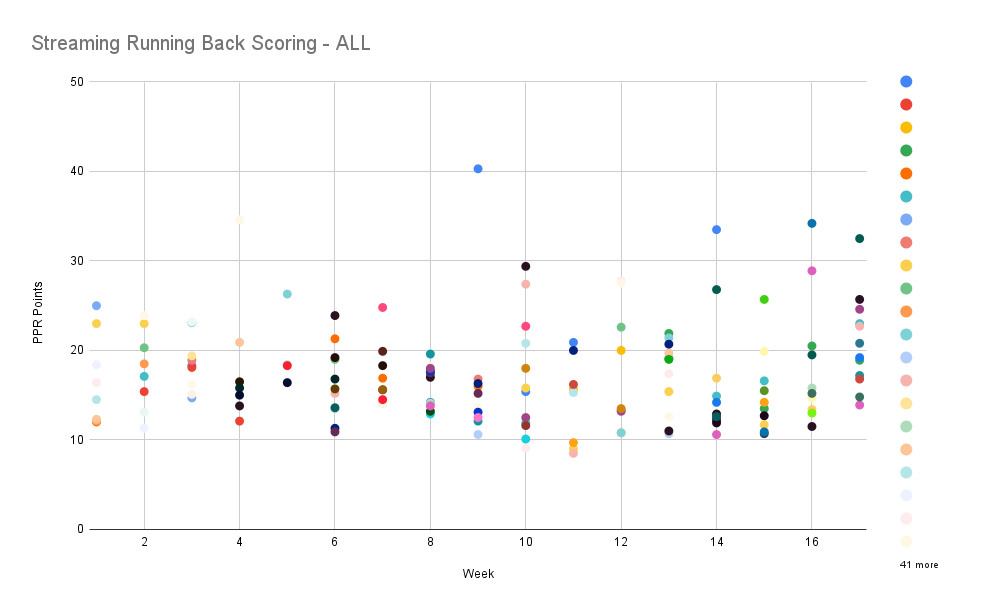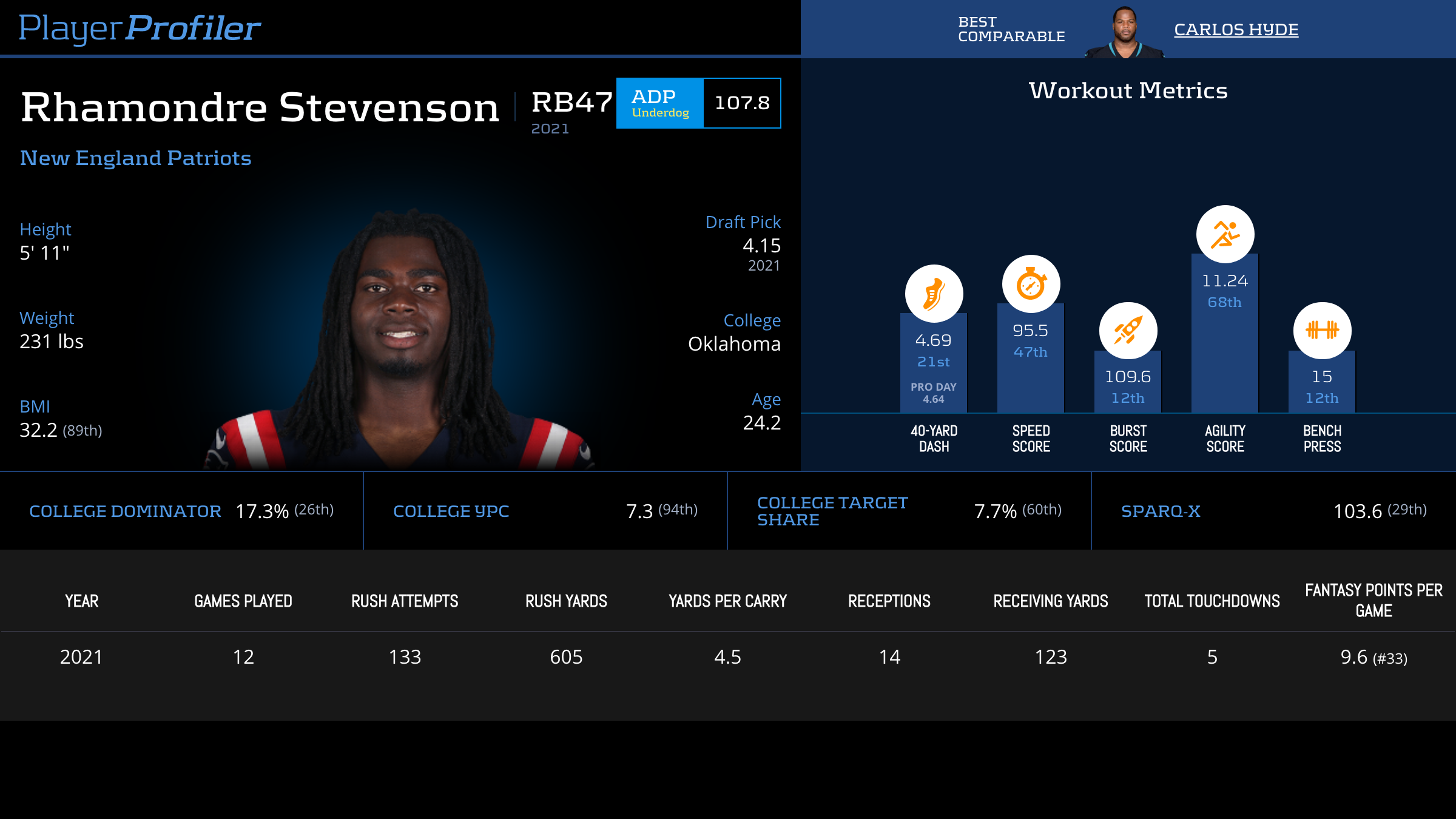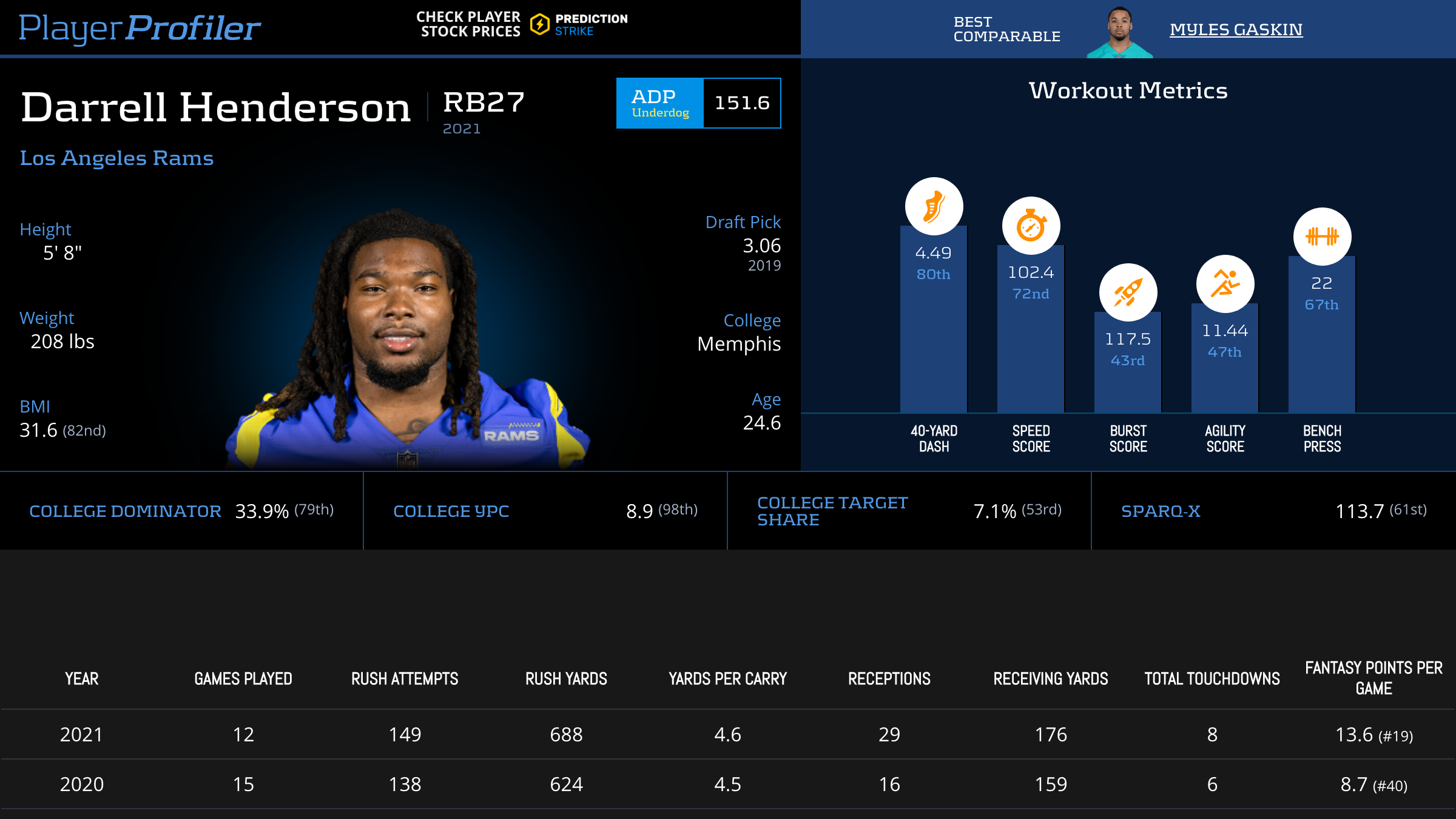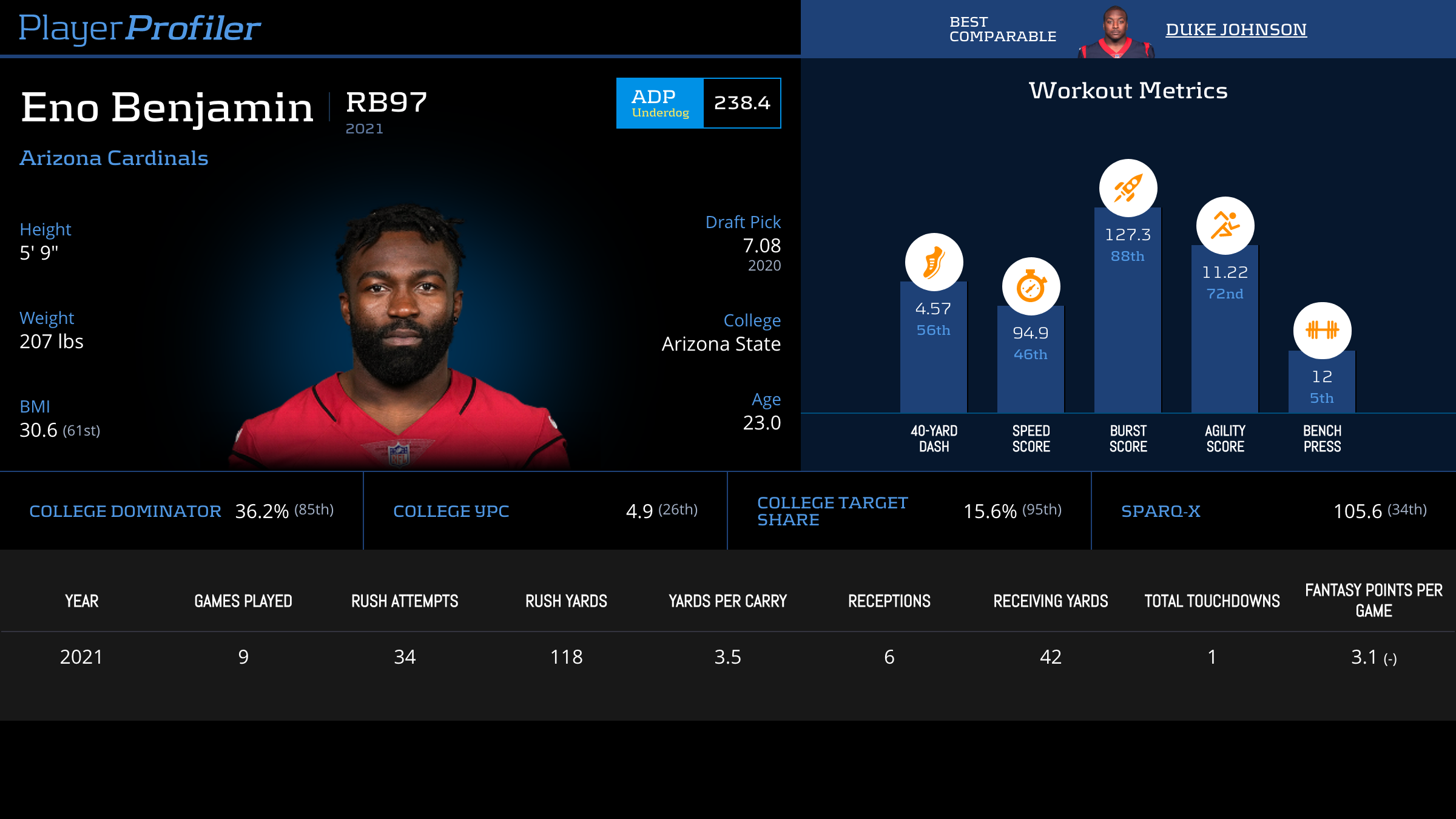Legend has it that Douglas Adams came up with the idea for his Radio Broadcast The Hitchhiker’s Guide to the Galaxy when gazing at the stars after hitchhiking through Austria. While I’ve never been to Austria, a lifetime of starting Ameer Abdullah, Darrel Williams and friends in your RB2 spot causes a similarly contemplative state. If you’ve followed my content this summer, you know I have generally been focused on long form strategy pieces regarding best ball and dynasty. However, with the season approaching, I wanted to provide weekly content to the underworld. As a high-volume Hero and Zero RB drafter, I decided a fun way to tie together larger strategy questions and weekly applicability was a streaming article devoted to the running back position.
In this article, I will cover the “too long don’t read” of Hero and Zero RB roster construction. I will also introduce the theory behind running back streaming. Then, in each coming week, I will use my late round draft targets outlined in this introduction. Also, I will use the pool of waiver options each week to attempt to stream a top 12 running back.
This is your Hitchhiker’s Guide to Running Backs.
The Fastest Possible Summary of the Zero-RB Strategy
The Zero RB strategy – originated by Shawn Siegele – is complex enough to write well over 10,000 words on. This article will not even scratch the surface. However it feels necessary to at least cover key tenants before I spend 17 weeks instructing you to start the most mediocre running backs in the NFL.
The Zero RB Principles
Like any strategy, it is dynamic to each draft and each league setting. But several principles are universally applicable:
I. Fantasy Production is largely a function of volume. However, the real football realities of running back and receiver create different paths for how volume manifests.
II. Running Back Production is largely a function of “given volume:” There are four-five pass catchers running a route on most pass plays. There is often only one running back on the field for each run play.
III. Receiver Production is largely a function of “earned volume:” target earning ability is roughly stable regardless of “competition” from teammates among receivers.
IV. Running Backs have a greater injury frequency than Receiver.
Put those four principles together, and you discover a consistent incentive structure to prioritize receivers early in drafts.
Receiver Production
Receiver production is driven to a greater degree by the inherent talent of the player. Therefore, it is thus more predictable from a season-long perspective. Therefore, it is not surprising that late round receiver selections have generally been poor bets for production. The exceptions are players we have the least amount of samples on. While such receivers will often pop into the top 24, it is not as projectable as with running backs. If a backup running back sees their starter get injured, we can projectably play them in our lineup in a way we can’t do guessing when Kendrick Bourne scores a touchdown.
If you're going to invest in late round WRs the most profitable ones to invest in have been either rookies or second year WRs
At least 50% of the WRs who returned a 10%+ best ball win rate drafted outside the top 100 over the last four years were either rookies or 2nd year WRs pic.twitter.com/5knTNANcDF
— Corey Buschlen (@FootballStock) August 19, 2022
Externalities
An ‘externality’ is an economics term which refers to any event which impacts the value of one good unrelated to the actions of that good’s producer. In a fantasy sense, it is an unforeseeable event which impacts a player’s value unrelated to their own talent. I have often said that playing fantasy football is about minimizing the harm of negative externalities and maximizing the benefit of positive externalities. As described above, running backs are more reactive to externalities in all directions. They are a highly dependent position on their offense, coaching, game script and usage for their production.
Maximizing Ceiling Outcomes
In order to maximize a ceiling outcome for a fantasy lineup, you need to consider outcomes in which you benefit from good fortune. Then, the task is to build your lineup to maximize that benefit. highly valued running backs are more likely to be negatively affected by their surroundings, unexpected changes in deployment, or injury. Therefore, late-drafted running backs are more likely to be the direct beneficiaries of this.
There is a subset of elite running backs with irreplaceable talent, three down skillsets and legendary upside. I will be the first to admit that if Christian McCaffrey gets injured, Chuba Hubbard nor D’Onta Foreman will replicate his fantasy value. However, in far more running back depth charts, the next man up can provide similar production to the week 1 starter:
N Chubb: 15.2 PPG
D Montgomery: 15 PPG
J Jacobs: 14.9 PPG
D Booker Weeks 5-9: 15.8 PPG
20.8
10.9
14.6
17.5
15.2D Williams Weeks 6-10: 17.8 PPG
23.9
8
17
10.7
29.4D Foreman W14-17: 14.1 PPG
C-Pat full-year: 14.5 PPG
Eli Mitchell full-year: 15.0 PPG
— Jakob Sanderson (@JakobSanderson) February 22, 2022
By filling RB2 with a late round pick, or waiver hit(s), you essentially have an impossible lineup to construct naturally. You’ve garnered early round production at a running back slot while focusing all your draft fire-power at receiver. In this column, we will grind the later rounds of your draft to identify the backs with the highest contingent value and best standalone production opportunity. As well, we will scour the waivers each week to find the Cordarrelle Patterson, Elijah Mitchell, or Darrel Williams of 2022, that unlocks an elite ceiling for your roster and wins you your league.
The Goal
The goal of this column is simple. Just as the hitchhiker attempts to achieve their destination without a consistent or known vehicle, we will reach your league championship relying on a mix of temporary solutions and unexpected revelations. I will attempt to stream the highest scoring season long RB2 slot we can, relying only on a finite pool of late round picks and the waiver wire. I will explain the parameters in detail at the end of the article.
Can Streaming Running Backs Work?
In a word, yes. However, you will need to be diligent in approaching the right choices on draft day, on waivers, and in your start/sit decisions. Let’s look at some 2021 data for an idea on the type of options available to us.
In last year’s fantasy season, over 40-percent of top 24 running back finishes were from running backs drafted after the first eight rounds. I chose this cut off because eight rounds fills your quarterback, tight end, and six receivers should you forego running backs entirely. This fits within Shawn Siegele’s stated goal of Zero-RB to find six top 15 receivers. (Note: you do NOT need to go without a running back for eight rounds to implement elements of this strategy. Especially in shallower leagues or half-PPR leagues, I recommend considering a “Hero RB” in the early rounds and containing your streaming to RB2)
Here was the weekly distribution of these top 24 finishes in 2021:
The yellow bars represent the total running backs drafted after round eight scoring in the top 24 each week; heretofore called “streamers.” The red line signifies the number of streamers per week drafted in late rounds. The blue line is un-drafted running backs. As you can see, the overall frequency of streamer RB2s rises as the season goes on, especially among the un-drafted streamers.
Streaming Ceilings and Frequency
The next chart shows each streaming category’s production by week compared to the week’s RB12 and RB24. Each line is comprised of the average of all top 24 streamers’ scores in the given week. Note that it ONLY counts the top 24 performances in the average. Therefore, I want to make clear: the streamers are NOT outperforming the RB24 on average. This is merely capturing the distribution of weekly ceiling. As you can see, un-drafted running backs routinely offer top 12 weekly ceilings.
Below is a slightly difficult to read chart, but it shows the distribution in production of every top 24 streaming running back by week. While your average streaming play is living in the 10-20 point range, there are streaming options breaching the 20-point mark almost every week. This is done with increased frequency toward the end of the season.
One last chart: this shows the number of times each streamer achieved a top 24 performance. The left side of the chart before the break is comprised of the drafted streamers. The right half shows the un-drafted streamers, ordered left to right by when their first top 24 performance occurred. Unsurprisingly, if you are looking for a consistent, year-long starter, they are either drafted by you or identified immediately. That being side, options like Devontae Booker, D’Onta Foreman, Sony Michel and Rashad Penny are exceptions. Each was able to produce consistent production for a finite window in time in the mid or late season.
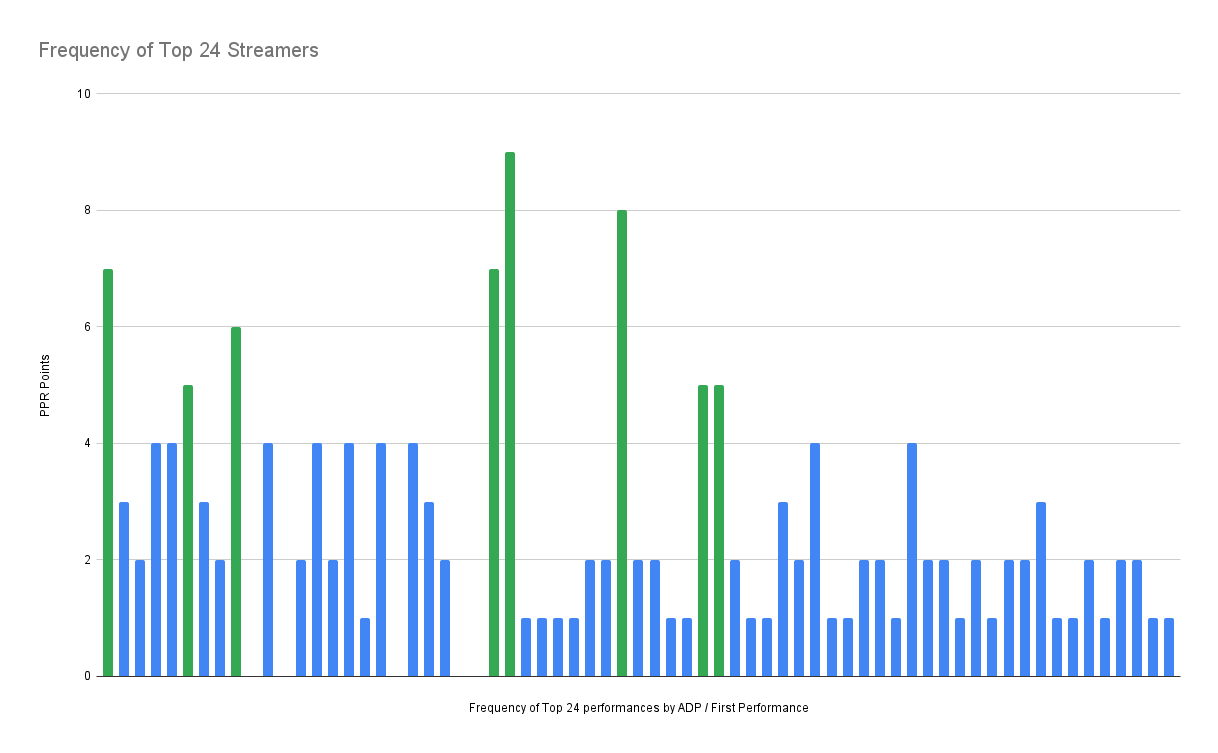 Takeaways
Takeaways
This data should be taken as more descriptive than anything else. It is not to say that streaming running backs is an optimal approach or perpetually repeatable with success. However, it does suggest to us that we can unlock a legitimate ceiling with streaming options, and it is possible to find stable options both in late rounds and on waivers. As well, we can glean some inferences from last year’s successful picks. The following options had at least five top 24 performances:
- James Conner
- Devin Singletary
- Tony Pollard
- Elijah Mitchell
- Cordarrelle Patterson
- Darrel Williams
- Devontae Booker
- Devonta Freeman
Ideal Running Back Scenarios
The majority of these running backs possess the size required of a three down back, and other than Mitchell, was able to combine a rushing and receiving role. Aside from Booker and Patterson, each was in a potent offensive environment. Three of these backs emerged as the leads from ambiguous backfields, while four others directly gained their relevance from injury. Pollard was the exception who was able to carve out a standalone role as a secondary back.
Looking forward, I am prioritizing rushers from strong offensive environments for running back production with a viable path to work in all phases. Depending on the part of the draft, I am open to either ambiguous backfields or pure handcuffs, but am avoiding drafting an abundance of pure satellite backs.
With that, let’s get into the specifics of the streaming project moving forward.
The Parameters
It is impossible to replicate in this article the actual decisions we have to make on our individual rosters, where our options comprise of the specific running backs we drafted, and the options on our individual waiver wire. For that reason, my hope is the commentary – on players, archetypes, and strategy – is the most universally applicable portion of the series.
However, to add in a level of accountability to the process, and for the fun of playing along, I want to establish ground rules for which I will select our hitchhikers each week.
Each week (after week one) I will discuss up to nine total running backs, often less depending on the week; three options in each category, with a preferred play for each. I will then take the average of my preferred plays in each category, with my official “rostered running back” counting double.
I will be tracking my scores in PPR.
The Categories
- Bench Streamers: In this article I will present my favorite running back selection in each round beginning in the ninth. These backs will comprise my “bench” for the year, and I will draw on them throughout the year as necessary as my streaming option. One rule: just like a real roster, for each “official” play I choose off waivers, I have to make a cut. I can cut any back from this list or a previously picked up streamer. Each time I cut a player from this list I forego the option of using that player as a streamer in the future unless they dip below the required roster-ship threshold for the next two categories. If a drafted player gets injured I retain one injured reserve spot.
- Premium Waiver Streamers: This group is comprised of any running back with less than 67-percent roster-ship on ESPN leagues as of the first waiver run of the week. This can include both generally un-drafted players, as well as previously drafted players who have been widely cut by managers.
- Deep Waiver Streamers: This group is comprised of any running back with less than 33-percent roster-ship on ESPN leagues. The same rules apply as above.
The Bench
This is a chance you only get once… to expend the precious draft capital available to me on the only commonly drafted running backs I am assured to have at my disposal in this column. I will be using the following baseline for my fictional league draft:
1QB, 2RB, 2WR, 1TE, 2Flex, 6BN, K, D.
I added the second flex, as this is an approach best built for leagues with an additional flex spot.
Therefore, this draft has 16 total rounds, with two being reserved for kicker and defense. As well, I cannot include any backs from the top eight rounds of ADP. (I have used 4-for-4’s ADP tool as my guide) Therefore, I am availed with one pick from each of Rounds 9-14; six total running backs.
Round 9 – Rhamondre Stevenson
Rhamondre Stevenson is the perfect choice for my highest capital selection. Stevenson has the appropriate size of a bell-cow running back, but what makes him unique is his pass-catching profile. The big-bodied Sooner was only behind Kenneth Gainwell in yards per route run (YPRR) in his rookie class. This carried over to the NFL where his 1.60 YPRR vastly outshone Damien Harris‘ 1.13. But Stevenson showed serious chops as a rusher as well; ranking 10th in PFF grade among running backs. This was backed up by an elite 35.4-percent juke rate: 4th in the league.
Beat reports expect Stevenson to take on the passing down role in the absence of James White and now Ty Montgomery. His path to a high-value touch role in a running back centred offense makes himn a priority target for both immediate and season-long upside.
Round 10 – Darrell Henderson
Darrell Henderson has risen up draft boards recently. However, he still goes too similar to the range he was drafted in 2021 PRIOR to Cam Akers‘ achilles tear. While Akers has no fallen three+ rounds from his 2021 ADP, Henderson remains firmly in Zero-RB territory. This is despite Henderson posting 13.6 points per game last year as the lead back. At worst, the former Memphis Tiger is one injury away from reprising that role. At best, he is the pass-catching half of a running back by committee in a high-scoring offense.
Henderson – similar to Stevenson – has the potential to provide both contingent and standalone value. This is crucial for a fast start and late season upside on your zero-RB team.
Round 11 – Nyheim Hines
Nyheim Hines has always been a strong Zero-RB target for weekly value. His standalone pass-catching role provides early-season stability while you wait on waiver options or contingent bets to pay off. However there are two reasons to think this year may be especially kind to Hines. The first is Matt Ryan; the engineer of Cordarrelle Patterson’s breakout 2021 season. From Patterson to Devonta Freeman, the pocket-passing Ryan is a fantasy-friendly option for pass-catching running backs.
The second possible out for Hines is the spectre of higher contingent upside than previously assigned his way. The Colts running back depth chart is very thin after him. Hines has been used as a three down back in pre-season and may not cede the early down rushes he has previously when the primary back has been injured. This would profile Hines closer to a Kareem Hunt or Tony Pollard than the pure satellite back he has been in the past.
The Colts treated Nyheim Hines like the backup to Jonathan Taylor in Week 1 of the preseason (with starters):
100% of snaps, including 100% of rushing attempts.
Hines is a great PPR option w/ juicy contingency upside. Going too late in fantasy drafts — RB45 (134 overall). https://t.co/28wLHpLvCc
— Dwain McFarland (@dwainmcfarland) August 30, 2022
Round 12 – Rachaad White
I’ve written glowingly about Rachaad White in previous articles but it bears repeating what an excellent selection he is in managed formats. The former sun-devil has prototypical size and speed, and boasted a 16-percent target share his final year in college. This fits hand-in-glove with Tom Brady‘s proclivity to use backs in the pass-game.
To make matters better, Tampa Bay led the National Football League in expected fantasy points to running backs last year, averaging 27.8 per game. This offense is a fantasy gold mine for running backs particularly in the passing game. Even an early-down complimentary role has the chance to offer pass-catching upside given the profile of White and Brady. Should Fournette suffer an injury however, White has an opportunity to challenge the throne of Tony Pollard and A.J. Dillon as the number one handcuff in fantasy football.
Thinking About Thinking: Heuristics for Dynasty Rookie Drafts
Round 13 – Khalil Herbert
The day three pick from Virginia Tech was a bright spot in a disappointing Bears season last year. Despite playing solidly behind David Montgomery, Herbert posted a No. 15 ranked juke rate. PFF rewarded his play with the 6th highest rushing grade and 15th highest overall grade among running backs.
Herbert – whose nickname is “Juice” – boasts more straight line speed than David Montgomery, portending a possibly better fit in the zone scheme play-caller Luke Getsy is implementing. While Herbert is a clear handcuff, the Bears offense is not one to target in a vacuum. I am choosing to make an exception here based on the odds Herbert is able to usurp Montgomery outright who has not been an efficient rusher in the national football league.
Round 14 – Eno Benjamin
Eno Benjamin has been a certified truther candidate of mine since entering the league. With sufficient size and athleticism, and dominant power five college production, Benjamin looks the part of a fantasy football machine. Boasting two 1,000 yard collegiate rushing seasons, his college target share at Arizona State peaked at 14.4-percent. Going into his third year in the NFL, there has been no indication Benjamin would fulfil this potential.
However, the word out of Arizona is that Benjamin has “forced his way onto the field.” With a wide open depth chart behind the oft-injured James Conner, Benjamin has a chance to earn a valuable standalone role and maintain elite contingent value to an offense which has been very friendly for a variety of running backs since Kliff Kingsbury arrived in Arizona. In fact, four running backs – all four to have a game with at least 50-percent of snaps – since Kingsbury’s hiring have had multiple 25-point performances. Benjamin is one injury away from joining David Johnson, Chase Edmonds, Kenyan Drake and James Conner this year.
Week One Selections
As mentioned earlier, this portion of the piece will look MUCH different in the forthcoming editions. Starting in week two I will be devoting almost the entirety of each article to selecting which backs to play the next week, including my rostered backs, and any waiver transactions. However this week is simple. I have only the players I “drafted” to choose from and so will pick all three selecctions from the above list.
Unfortunately, the best three week one plays also appear to be the three I drafted earliest. Nyheim Hines is valued primarily for his every-week role and fits nicely as an RB2 on any Zero-RB / Hero-RB build. The Rams backfield has much more volatility, but Darell Henderson should be involved to a point. In a shootout against the Bills I want access to, Henderson makes my list this week.
Last but not least, my preferred play is Rhamondre Stevenson. His score will thus count double this week. Stevenson – with Ty Montgomery likely out week 1 – is set to take on major work in all phases of the game. If the role shakes out as fantasy managers hope, he offers immediate plug and play RB2 value.
The Final Word
When you are implementing any form of Zero-RB strategy, the draft is just step one. So too is this article. I look forward to seeing you again each week as we manage our running back roster and hitchhike our way to a championship.

